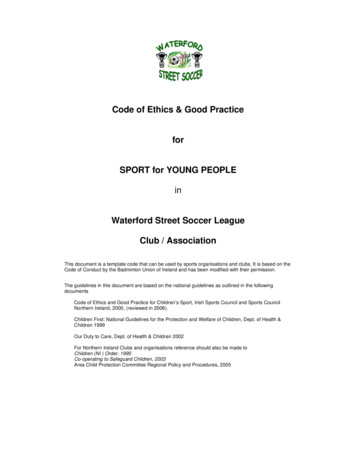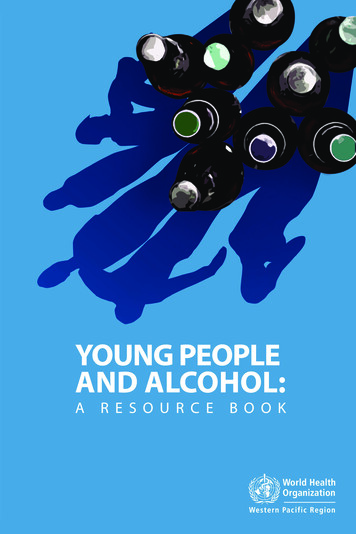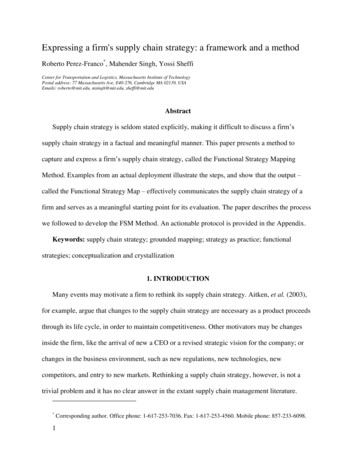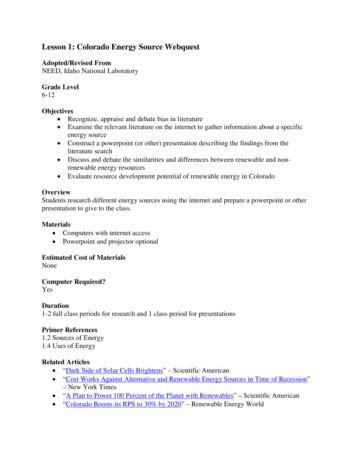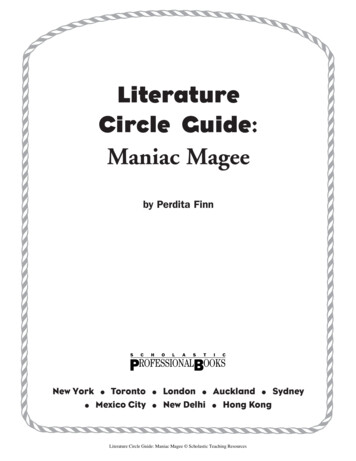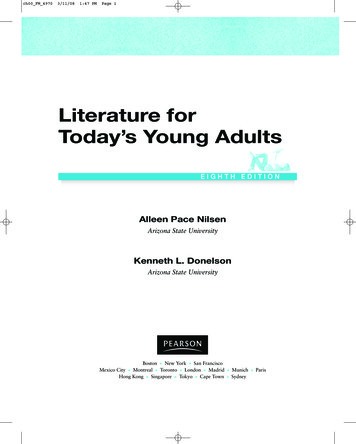
Transcription
ch00 FM 49703/11/081:47 PMPage iLiterature forToday’s Young AdultsEIGHTH EDITIONAlleen Pace NilsenArizona State UniversityKenneth L. DonelsonArizona State UniversityBoston New York San FranciscoMexico City Montreal Toronto London MadridHong Kong Singapore Tokyo Cape Town MunichSydney Paris
ch00 FM 49703/11/081:47 PMPage iiExecutive Editor: Aurora Martínez RamosSeries Editorial Assistant: Kara KikelExecutive Marketing Manager: Krista ClarkProduction Editor: Annette JosephEditorial Production Service: Publishers’ Design and Production Services, Inc.Composition Buyer: Linda CoxManufacturing Buyer: Megan CochranElectronic Composition: Publishers’ Design and Production Services, Inc.Interior Design: Denise HoffmanCover Administrator: Kristina Mose-LibonFor related titles and support materials, visit our online catalog atwww.pearsonhighered.com.Copyright 2009, 2005, 2001 Pearson Education, Inc.All rights reserved. No part of the material protected by this copyright notice may bereproduced or utilized in any form or by any means, electronic or mechanical, includingphotocopying, recording, or by any information storage and retrieval system, withoutwritten permission from the copyright owner.To obtain permission(s) to use material from this work, please submit a written request toAllyn and Bacon, Permissions Department, 501 Boylston Street, Suite 900, Boston, MA02116 or fax your request to 617-671-2290.Between the time website information is gathered and then published, it is not unusual forsome sites to have closed. Also, the transcription of URLs can result in typographical errors.The publisher would appreciate notification where these errors occur so that they may becorrected in subsequent editions.Library of Congress Cataloging-in-Publication DataNilsen, Alleen Pace.Literature for today’s young adults / Alleen Pace Nilsen, Kenneth L. Donelson. — 8th ed.p. cm.Authors’ names appear in reverse order in 7th ed.Includes bibliographical references and index.ISBN-13: 978-0-205-59323-1 (alk. paper)ISBN-10: 0-205-59323-21. Teenagers—Books and reading—United States. 2. Young adult literature—Historyand criticism. 3. Young adult fiction—History and criticism. 4. Young adultliterature—Bibliography. 5. Young adult fiction—Bibliography. I. Donelson, Kenneth L.II. Title.Z1037.A1D578 2008028.5'5—dc222008002625Printed in the United States of America10 9 8 7 6 5 4 3 2 1 RRD MO 12 11 10 09 08Photo credits and acknowledgments appear on pages 453–454, which constitute anextension of the copyright page.Allyn & Baconis an imprint ofwww.pearsonhighered.com
ch00 FM 49703/11/081:47 PMPage iiiTo the memory ofOur dear friend and teacher,G. Robert Carlson,1917–2003And to our grandchildrenand great-grandchildren,Who are happily finding many of these books:From AlleentoTaryn, Britton, Kami, Erich, David, Lauren,Michael, Jenna, Avery,Jim, and LukeFrom KentoKayden, Haylee, Emiley, and Dylann
ch00 FM 49703/11/081:47 PMPage iv
ch00 FM 49703/11/081:47 PMPage vAbout the AuthorsKen Donelson and Alleen Nilsen, professors of English at Arizona State University,became friends and colleagues before theymet each other. They both earned their Ph.D.degrees at the University of Iowa from G.Robert Carlsen, a pioneer in the field ofyoung adult literature. Ken was Carlsen’s firstPh.D. student, with Alleen coming along adecade later. When Alleen and her husbandmoved to Arizona State in 1973, one of thefirst people she visited was Ken because Professor Carlsen had talked about him in classand had recruited Alleen as a writer for theArizona English Bulletin, which Ken wasediting.Nevertheless, Professor Carlsen wassurprised when his two former students, whohappened to find themselves in the same partof the country, started working together because he thought they were so different. Ken writes like a historian, focusing on what’s old, while Alleen writeslike a journalist, focusing on what’s new. And while Ken was a leader in fighting censorship, Alleen was a leader in fighting sexist language, which somepeople interpret as a form of censorship. She is the one who suggested theytake turns with whose name goes first on each edition.In spite of their differences, what they learned from Professor Carlsenbrought them together in support of the academic study of young adult literature. In 1973, they helped found ALAN (Assembly on Literature for Adolescents of NCTE); both have received ALAN’s Award for “OutstandingContributions to the Field of Young Adult Literature,” and both served aspresidents of ALAN. In 1974, they were the founding editors of The ALANNewsletter, the forerunner of what is now The ALAN Review.After proving that they respected each other and could work together, theyapplied to be coeditors of the English Journal, a job they held from 1980 to1987 when they wrote the first edition of Literature for Today’s Young Adults.Thanks to Ken’s knowledge of history and his interest in censorship, the bookwas more complete than other textbooks of the time which mostly focused onrealistic problem novels—books sometimes identified as bildungsroman orapprenticeship novels—which are still the books most obviously identified asYA. But what Ken and Alleen demonstrated was that every genre, from adven-
ch00 FM 49703/11/081:47 PMPage viture and biography to mysteries, fantasy, poetry, and the supernatural, werebeing written for teenagers and deserved a place in schools and libraries. Andbecause Alleen’s first job at Arizona State University was teaching in theDepartment of Library Science in the College of Education, it seemed naturalfor them to bring in the work of librarians and reading teachers as well as ofEnglish teachers.What has kept Literature for Today’s Young Adults the leading textbookin the field is the authors’ continuing love and enthusiasm for their chosen fieldof study. For each edition they have highlighted new and interesting trends andillustrated them with lively discussions of well-written books. It has helped thatthey are well-rounded scholars and have remained active in education as awhole.Ken has published over five hundred articles, mostly on censorship, YAbooks, and problems in teaching secondary English reflecting his thirteen yearsof teaching high school English in Iowa. His articles, as well as others relatedto college teaching, have appeared in such journals as Clearing House, EnglishJournal, High School Journal, and School Library Journal. Ken collected YAbooks published from 1850 through 1950 and when he retired from ASU hedonated some eight hundred historical YA books and a nearly complete run ofThe Dime Novel Round-Up to ASU’s Hayden Library. The collection is strongin books by Kirk Munroe, Ralph Henry Barbour, and John Tunis, and in twoStratemeyer Literary Syndicate heroes, Tom Swift and Nancy Drew.Alleen has worked with her husband, linguistics Professor Don L. F.Nilsen, to promote a new approach to the teaching of vocabulary, as explainedin Vocabulary Plus: High School and Up: A Source-Based Approach andVocabulary Plus K–8: A Source-Based Approach (Pearson, 2004). TheirEncyclopedia of 20th-Century American Humor (Oryx/Greenwood) was chosen by the American Library Association as one of the twenty best referencebooks published in 2000. In 2007, they published Names and Naming inYoung Adult Literature as part of the Scarecrow Series in Young Adult Literature, edited by Patty Campbell. Alleen is also the author of Joan Bauer, thefirst book in Greenwood Press’s series Teen Reads: Student Companions toYoung Adult Literature (2007), edited by James Blasingame.
ch00 FM 49703/11/081:47 PMPage viiBrief Contentspart oneUnderstanding Young Adults and Books1chapter 1Young Adults and Their Reading1chapter 2A Brief History of Young Adult Literaturechapter 3New Technology, New Attitudes, and New Literacies3977part twoModern Young Adult Reading111chapter 4Contemporary Realistic Fiction: From Tragediesto Romances111chapter 5Poetry, Drama, Humor, and New Mediachapter 6Adventure, Sports, Mysteries, and the Supernaturalchapter 7Fantasy, Science Fiction, Utopias, and Dystopiaschapter 8History and History Makers: Of People and Placeschapter 9Nonfiction: Information, Literary Nonfiction, Biographies,and Self-Help Books277147183215243part threeAdults and the Literature of Young Adults311chapter 10Evaluating, Promoting, and Using Young Adult Bookschapter 11Young Adult Literature in the English Classchapter 12Censorship: Of Worrying and Wondering311355387vii
ch00 FM 49703/11/081:47 PMPage viii
ch00 FM 49703/11/081:47 PMPage ixContentsSpecial FeaturesPrefacexviixivpart oneUnderstanding Young Adults and Bookschapter 11Young Adults and Their ReadingWhat Is Young Adult Literature?A Word about Spoilers119Stages of Literary Appreciation10A University of Exeter Study on the Qualities of Good YA BooksThe Honor List: The Best of the Best, 1980–2007Noteschapter 2172138A Brief History of Young Adult Literature1800–1900: A Century of Purity with a Few Passions39411900–1940: From the Safety of Romance to the Beginning of Realism1940–1960: From Certainty to Uncertainty1960–1980: Uncertainty Becomes TurbulenceNoteschapter 350596575New Technology, New Attitudes, and NewLiteracies77A New Kind of Democracy with an Emphasis on YouthCritical Literacy8492Visual Literacy for the Eye GenerationReligious and Ethnic Literacy9595ix
ch00 FM 49703/11/081:47 PMPage xGlobal Literacy97Deciding on the Literary CanonTeaching Ethnic LiteratureNotes103106109part twoModern Young Adult Readingchapter 4111Contemporary Realistic Fiction: From Tragedies toRomances111What Do We Mean by Realism?113The Modern Problem NovelWhat Are the Problems?122More Optimistic Novels132Concluding CommentsNoteschapter 5114145146Poetry, Drama, Humor, and New MediaA New Day for Poetry147The Teaching of Poetry154Making Drama a Class ActHumor Matters155163Comic Books and Graphic NovelsVideo Games as Interactive LiteratureConcluding CommentsNoteschapter 6182Adventure, Sports, Mysteries, and theSupernatural183183Sports and the Game of LifeMysteriesContents177182Adventure Storiesx174198193147
ch00 FM 49703/11/081:47 PMPage xiStories of the Supernatural208Concluding CommentsNoteschapter 7214214Fantasy, Science Fiction, Utopias, andDystopias 215What Is Fantasy?216What Is Science Fiction?Utopias and Dystopias238Concluding Comments241Noteschapter 8231242History and History Makers: Of People andPlaces243Historical FictionWesterns243255Books about War259Literature of the HolocaustBooks about Vietnam272Concluding CommentsNoteschapter 9267276276Nonfiction: Information, Literary Nonfiction, Biographies,and Self-Help Books277Information Books278Narrative or Storytelling in NonfictionMemoirs and Personal onfiction to Help Teenagers Learn Who They Are andWhere They Fit299Outstanding Authors of Nonfiction for Young AdultsConcluding CommentsNotes304310310Contentsxi
ch00 FM 49703/11/081:47 PMPage xiipart threeAdults and the Literature of Young Adultschapter 10311Evaluating, Promoting, and Using Young AdultBooks311A Report on Our Survey of 266 Teens312Borrowing a Philosophy from Teachers of Physical EducationWays of Teaching While Offering Students Choices322Evaluating and Promoting Young Adult LiteratureYoung Adult Literature in the Library334337Young Adult Books in the Reading Classroom346Young Adult Books in the Social Studies ClassroomParents and Young Adult LiteratureClarifying Human Relations and ValuesConcluding CommentsNoteschapter 11351352354354Principles of Teaching EnglishUsing Short StoriesUsing Novels366369Using Young Adult Literature in Creative WritingThematic Units374381Film and Television383Concluding Comments385386Censorship: Of Worrying and WonderingA Censorial Spirit387A Sampling of Early Attitudes toward CensorshipMore Recent Attitudes on CensorshipAttacks on Materials397390393Some Assumptions about Censorship and CensorsContents357361Literature Circlesxii355355Using Young Adult Literature in English Classeschapter 12349Young Adult Literature in the English ClassNotes320394387
ch00 FM 49703/11/081:47 PMPage xiiiSome Court Decisions Worth KnowingA New Kind of Censorship402415What to Do before and after the Censors ArriveConcluding CommentsNotes417426426A Starter Bibliography on Censorship427appendix AGlossary of Literary Terms Illustrated by YA Literatureappendix BBook Selection Guidesappendix CSome Outstanding Books and Articles about Young AdultLiterature443Acknowledgments439453Authors, Critics, and Commentators IndexSubject IndexTitle Index433455465467Contentsxiii
ch00 FM 49703/11/081:47 PMPage xivSpecial FeaturesMargaret A. Edwards AwardWinnerS. E. Hinton, The One Who Changed It All(1988)8Robert Lipsyte, A Contender All the Way(2001)197Madeleine L’Engle, A Writer Who Asks the HardQuestions (1998)15Lois Duncan, A True Storyteller (1992)Robert Cormier, Who Took It to the Top(1991)72Judy Blume, Who Endures (1996)207Ursula K. Le Guin, Master of Fantasy(2004)222Anne McCaffrey, The Dragon Lady(1999)22574Francesca Lia Block, The Bringer of MagicalRealism (2005)82Lois Lowry, Who Gave Us The Giver(2007)239Cynthia Voigt, A Writer Who Keeps on Learning(1995)137Walter Dean Myers, Bringing the Arts to aSecond Generation (1994)257Orson Scott Card, A Writer with Talent andVersatility (2008)144Richard Peck and the Magic of the Journey(1990)275Paul Zindel and His Legacy (2002)M. E. Kerr, A Genius with Names (1993)164331Gary Paulsen, Adventurer and More(1997)187Jacqueline Woodson, Writing Against the Fear(2006)371Chris Crutcher and His Sports-Plus Novels(2000)195Nancy Garden, Stretching Our Minds onSexuality (2003)414Honor ListThe Best of the Best, 1980–2007Young Adult Authors Speak OutMichael Cart on the Importance of Young Adult Literature5Cynthia Leitich Smith on Hosting 1.6 Million Visitors in CyberspaceNaomi Shihab Nye on the Poetry Bridge153Aaron Levy, Dramatist, Speaks to English Teachers and LibrariansStefanie Craig, A Manga Lover Speaks to TeachersJames Cross Giblin on an Author’s MotivationsPat Mora on Linguistic Wealth178281346Vivian Vande Velde on “Dear Cranky Author . . .”Kimberly Willis Holt on the UnexpectedLaurie Halse Anderson on Censorship9837742137515821
ch00 FM 49703/11/081:47 PMPage xvFocus Boxes1.1 Books to Help AdultsUnderstand Teenagers367.1New Fantasy for Young Teens7.2Reality May Not Be Fantasy, But Fantasy IsReality220372191.2Memoirs by Outstanding YA Authors2.1A Sampling of Books Appreciated by YoungAdults 1864–1959427.3Science Fiction Tells about Our Future So WeCan Know the Present2322.2New Tellings of Old Stories7.4Utopias and Dystopias in YA Fiction2.3A Sampling of Good Books fromthe Sixties668.1Historical Fiction about the UnitedStates2462.4A Sampling of Good Books fromthe Seventies678.2Historical Fiction about the World8.3New Books about the History of the Civil RightsMovement254442402473.1Help for Adults in Developing NewLiteracies788.4New Books about Native Americans3.2“Different” Literacies in YA Books808.5Westerns Too Tough to Die3.3Newly Translated YA Books with StarredReviews1008.6War’s Effects on Young People4.1Challenges: Physical and Mental8.7Experiencing the Holocaust to Keep It fromHappening Again2714.2Dying Is Easy; SurvivingIs Hard1204.3Buddies andBullies1254.4Family TiesRelating acrossCultures1294.6Literal Journeys/FigurativeQuests1382602668.8 Nonfiction Books aboutVietnam274Film Boxes1274.51162569.1 Intriguing Facts9.2 Careers1.1The World of YoungAdults27.1Fantasy, Science Fiction,and Dystopias2332802889.3 Humanities andthe Arts2909.4 RecentBiographies2969.5 Information about Bodiesand Minds3004.7Love and Friendship1415.1Stories Told through Free-Verse Poetry5.2More Poets and Poetry5.3Plays Commonly Read in EnglishClasses1605.4Books Recommended for Reading Aloud orAdapting into Reader’s Theater1625.5Books to Make Readers Smile5.610.1Names and Naming in MulticulturalBooks33310.2Good Internet Resources for Teachers andLibrarians34410.3Teenagers outside the ContinentalUnited States35011.1New Professional Books to Help Teacherswith YA Lit358Sources of Information about Humor andGraphic Novels17211.2Old and New Recommended Collections ofShort Stories3656.1Real People Challenging Nature11.3Encouragement for Student Writers6.2An Armful of YA Sports Fiction11.46.3Sports Nonfiction—Real-Life DreamsPublication Opportunitiesfor Young Writers3806.4A Century of Accessible Adult Mysteries (ListedChronologically)20112.1Censorship and Free Speech in Booksfor Young Readers4206.5The Supernatural in YA Fiction12.2Online Resources on Censorship150156170192194209199379424Special Featuresxv
ch00 FM 49703/11/081:47 PMPage xvi
ch00 FM 49703/11/081:47 PMPage xviiPrefaceWe began our first preface back in 1980 with these words: “Wehad many reasons for writing this book, but chief among themwas our belief that it was needed and worth doing.” We believed in those wordsthen and we believe in them now. We hope that our eighth edition will continueto answer the needs of teachers and librarians, neophytes and old-hands alike.One of the saddest parts of growing old—other than watching the Cubs blowtheir race over and over—is watching literary tastes change and once-favoredbooks slowly go out of fashion and drop off recommended reading lists. Today,for example, we have writers as fine as these being avidly read and recommended:David Almond, Laurie Halse Anderson, M. T. Anderson, Kimberly Willis Holt,John Green, David Klass, Stephenie Myers, Nancy Werlin, Ellen Wittinger, andMarkus Zusak. And some writers continue to write books that win praise andreaders: Avi, Joan Bauer, Aidan Chambers, Chris Crutcher, Nancy Farmer, NancyGarden, Diana Wynne Jones, Ursula K. Le Guin, Robert Lipsyte, Walter DeanMyers, Gary Paulsen, Richard Peck, and Vivian Vande Velde.All that’s to the good. It’s great to have new authors hit new notes andstandard authors continue to produce provocative books. But what of the oncereliable writers who were constantly on the lists of worthwhile young adultbooks? What of the writers who, once hot, are increasingly forgotten? Whatof the Norma Kleins or the M. E. Kerrs? And what of writers as fine as: AliceChildress, James Forman, Bette Green, Rosa Guy, Isabelle Holland, Mildred Lee,Margaret Mahy, Zibby Oneal, Todd Strasser, Julian F. Thompson, and JohnRowe Townsend?Ten of Ken’s favorites whom we rarely see mentioned today are Nancy Bond,Bruce Clements, John Donovan, Jane Gardam, Monica Hughes, Irene Hunt, Sandra Scoppettone, Walter Wangerin, Barbara Wersba, and Robert Westall. Andhe is more than a trifle irritated about the fact that Harry Mazer’s The IslandKeeper is out of print. The way young adult literature is marketed is a major concern for all of us.In a preface, it’s customary to mention lots of names—graduate assistants,members of the department who have contributed this or that, graduate studentswho are doing wondrous things. We’ll do that in a few moments.First, we’d like to list some names that rarely get mentioned, unless it’s asfootnotes. We’re referring to critics and historians and commentators of all sorts,people who have written about young adult (YA) literature and who have taughtus to be critical and to recognize what is worth knowing about YA literature andwhat is ephemeral, what is new and flashy and what is sound and worth knowing. We say this knowing that individual critics may not recognize what Nilsenand Donelson learn from them, but we say sincerely that we have read andPrefacexvii
ch00 FM 49703/11/081:47 PMPage xviiilearned from all of them, and we truly believe that our writing—not necessarilythis book but whatever we have under way—is the better for having read thesegood people. In alphabetical order, we salute them: Gillian Avery, Dorothy Broderick, Mary Cadogan, Michael Cart, Aidan Chambers, Mary K. Chelton, SheilaEgoff, Jerry Griswold, Peter Hunt, Fred Inglis, Deidre Johnson, Monica Kiefer,Teri S. Lesesne, Anne Scott MacLeod, Cathi Dunn MacRae, Maria Nikolajeva,Bob Probst, David Rees, Hazel Rochman, William Sloane, Bob Small, Mary F.Thwaite, and John Rowe Townsend.We saved one name for special commendation for all she’s contributed toyoung adult literature. Patty Campbell has done so much for so many people itis difficult to mention specifics, but here are a few of her accomplishments. Hercolumns in the Wilson Library Bulletin and the Horn Book Magazine have madeher one of the most quoted writers in our field. Her editing of the Twayne YoungAdult Writers series and the Scarecrow Studies in Young Adult Literature hasprovided work on authors and topics valuable to us and to our students. We aresure there are things she cannot do, but we have no idea what they are.Anyone who has read in the history of English education will recognize howmuch we owe the spirits of four great master teachers and writers, four peoplewho were devoted to young students and their literature—Samuel Thurber, DoraV. Smith, Lou LaBrant, and Dwight Burton. Without them and their words therewould never have been a reason for a book like this.Another group, one even closer to heart and home, is made up of friendsand colleagues we have known over the years from our work at the University ofIowa, Arizona State University, and in the National Council of Teachers of English, the Conference on English Education, ALAN, the International ReadingAssociation, and assorted other groups. Here are a few people, some now gone,a coterie who meant much to us. We worked with them and argued with themand learned from them—and maybe they even learned from us: Dick Abrahamson, Bruce Appleby, Jackie Cronin, Chris Crowe, Hazel Davis, Bryant Fillion,Don Gallo, Beverly Haley, Bob Harvey, Ted Hipple, Terry Ley, Ben and BethNelms, Maia Pank Mertz, Bill Ojala, Linda Shadiow, John Simmons, David Sohn,Diane Tuccillo, Anne Webb, Jerry and Helen Weiss, and Carol Williams.And now to thank the people here at ASU who helped with this eighth edition, we need to mention our Department Chair Neal Lester and our colleagueJames Blasingame. Erika L. Watt served as an amazing editorial assistant, doingeverything from tallying the results of our survey, to gathering photos and permissions and even posing for pictures herself (see p. 425). The teachers and student teachers who administered our survey include Nicole Ainsworth, BekkaBesich, Jeri Brimhall, Kate Copic, Cynthia Kiefer, Frank Machado, and JessicaZellner. We also thank Nichole Gilbert from the Young Adult Library ServicesAssociation of ALA for helping us obtain author photos.And again we thank Aurora Martínez, the executive editor at Allyn andBacon, who supported us on this edition, along with the reviewers that shearranged for. We are grateful for the guidance of Beverly J. Hearn, University ofTennessee at Martin; Raymond P. Kettel, University of Michigan–Dearborn;Carol B. Tanksley, University West Florida; and Joy L. Wiggins, University ofTexas at Arlington. Thanks to their suggestions, we made the following changes:xviiiPreface
ch00 FM 49703/11/081:47 PMPage xix We devoted one page to the winners of the Margaret A. Edwards Award,which is given annually to an author in honor of a significant contributionto young adult literature. The award is sponsored by the School LibraryJournal and the Young Adult Library Services Association of the American Library Association. We were happy to do this as a reflection of howmuch growth has taken place in our field over the last two decades. Because of devoting these twenty pages to the Edwards Award winners, weinvited fewer other authors to contribute statements, but we are pleased atthe variety and the content of those who allowed us to use some of theirwords: Our thanks to Laurie Halse Anderson, Michael Cart, StefanieCraig, James Cross Giblin, Kimberly Willis Holt, Cynthia Leitich Smith,Aaron Levy, Pat Mora, Naomi Shihab Nye, and Vivian Vande Velde. Again we tried to cut down on the length of transitional material by moving more books out of paragraphs and into focus boxes or time lines. Over Ken’s objections, we moved even more of his material on films toour website, not because we disagree that film can be a wonderful teaching tool but because teachers tell us that in today’s schools the study of fulllength films has virtually disappeared. And also to save space, we cut down on the printing of the kinds of thingsthat change rapidly and that can easily be found through Internet searches;for example, the addresses and prices of popular magazines and otherURLs that are likely to change. In hopes of gaining some insights into just what people mean when theytalk about “new literacies,” we conducted a fairly extensive survey with266 students attending various high schools and one junior high school inthe metropolitan Phoenix area. We also launched a Media Watch duringthe first four months of 2007. See Chapters 3 and 10 for what we learned. And of course we have tried to find and include information on worthynew books, but we will be the first to admit that just because we haven’tincluded a particular book in our discussions or focus boxes, you shouldnot dismiss it from consideration. The field is so lively, with so many goodbooks coming out, that we could not possibly have found them all.We’ve often told our friends that while writing this textbook is a labor of love,it hangs over our heads sort of like the Golden Gate Bridge, which we’ve been toldis constantly being repainted because as soon as the painters get to the end, it’stime for them to go back and start scraping the rust from the other end. If we’vemissed some spots here and there, please forgive us, but also know that we will behappy to hear from readers so that we can make additions and corrections.As a good-luck talisman, we will end by repeating the quote from EdwardSalmon, which we started out with when it was only 90 years old. We agree withits sentiments even more now that it is closer to 120 years old.It is no uncommon thing to hear children’s literature condemned as wholly bad,and some people are good enough to commiserate with me on having wadedthrough so much ephemeral matter. It may be my fault or my misfortune not to bePrefacexix
ch00 FM 49703/11/081:47 PMPage xxable to see my loss. I have spent many pleasant and I may say not unprofitablehours in company with the printed thoughts of Mr. Kingston, Mr. Ballantye, Mr.Henry, Jules Verne, Miss Alcott, Miss Meade, Mrs. Molesworth, Miss Doudney,Miss Yonge, and a dozen others, and hope to spend as many more in the time tocome as a busy life will permit. (“Should Children Have a Special Literature?”The Parents’ Review 1 [ June 1890]: 339)And that, really, is why we are happy to have been given the privilege ofwriting—and rewriting—this textbook.Alleen Pace NilsenKenneth L. DonelsonxxPreface
ch01 49703/12/089:34 AMPage 1part oneUnderstanding Young Adults and BooksYoung Adults andTheir Readingchapter1O“f all passages, coming of age, or reaching adolescence is thepurest, in that it is the loneliest. In birth one is not trulyconscious; in marriage one has a partner, even death is faced with a life’s experience by one’s side,” wrote David Van Biema for a special issue of Life magazine devoted to The Journey of Our Lives.He went on to explain that going from boy or girl to man or woman is “ahuge leap on the slimmest of information.” The person who fails grows older without growing wiser and faces ostracism, insanity, or profound sorrow. Because sucha debilitated or warped individual is a “drag on the community,” the communitybands together with the young person to see that the journey is accomplished.1Life would go more smoothly if young people’s aspirations were simply tostep into the roles of their parents. The job of growing up, however, is moredemanding because, at the same time that young people are trying to becomeadults, they are also trying to show that they are different from their parents.This leaves each generation scrambling to find its own way to be unique, whichis one of the reasons that literature for young adults tends to be a contemporary medium. Each generation wants its own stories. See Film Box 1.1 on page2 for some of these stories told on the screen.What Is Young Adult Literature?We have heard young adults defined as those who think they’re too oldto be children but who others think are too young to be adults. In this book, we1
ch01 49703/12/089:34 AMPage 2Film Box 1.1The World of Young AdultsAmerican Graffiti (1973, color, 112 min., PG; Director:George Lucas; with Richard Dreyfus, Ron Howard, andCindy Williams) Here is high school graduation in 1962and what a few students learn about the real world.Bend It Like Beckham (2003, color, 112 min., PG-13;Director: Gurindor Chadha; with Parminder Nagra) Inthis British film, Jess is an Anglo-Indian teenager whohas grown up in London and loves soccer, but her traditional Sikh parents don’t want her to play.The Breakfast Club (1985, color, 97 min., R; Director: JohnHughes; with Emilio Estevez, Judd Nelson, Molly Ringwald, Anthony Michael Hall, and Ally Sheedy) Somecritics credit Hughes with creating the genre of YAmovies in this story about five rebellious teenagersassigned Saturday morning detention.Fast Times at Ridgemont High (1982, color, 92 min., R;Director: Amy Heckerling; with Sean Penn, JenniferJason Leigh, and Judge Reinholdt) California highschool students spend most of their time in the mallthinking about drugs and sex.Finding Forrester (2001, color, 135 min., PG-13; Director:Gus Van Sant; with Sean Connery and Rob Brown) Areclusive writer serves as a friend and mentor to a basketball player on scholarship at an exclusive New Yorkprep school.Juno (2007, color, 92 min., PG-13; Director: Jason Reitman;with Ellen Page, Michael Cera, Jennifer Garner, JasonBateman, Allison Janney, and J. K. Simmons) It wasn’tthe situation (a teen pregnancy) but the characterization that made Roger Ebert nominate Juno as the bestfilm of
donated some eight hundred historical YA books and a nearly complete run of The Dime Novel Round-Up to ASU’s Hayden Library. The collection is strong in books by Kirk Munroe, Ralph Henry Barbour, and John Tunis




